
Andy Lloyd's Dark Star Blog

Blog 41 (August 2016)
On Proxima b
August 2016 saw the announcement of the discovery of an Earth-like planet orbiting our nearest neighbourhood star - the red dwarf Proxima Centauri. The official press release was preceded by a leak to the German media from within the team of astronomers. Here, I tell the story of the rumours of the announcement, and the wider implications of the discovery itself:
Rumours of an Earth-like Planet Orbiting Proxima Centauri
The German magazine Der Spiegel has reported that a major announcement is imminent: there is an Earth-like planet orbiting the red dwarf star Proxima Centauri; the Sun's closest stellar neighbour at 4.24 light years distance. The magazine claims that the discovery was made by the European Southern Observatory (ESO) using the La Silla Observatory's reflecting telescope in Chile, based upon a leak from an astrophysicist who has been working with the La Silla team (1).
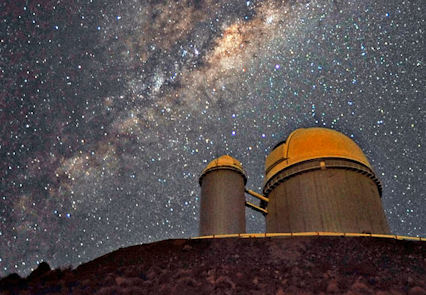
ESO's 3.6m Telescope at La Silla, Chile
This alleged discovery is in keeping with the current work being carried out at La Silla, as described in January earlier this year:
"What good news that the Pale Red Dot project is now planning a two-month observing campaign to search for potential Earth-analogs around Proxima Centauri using HARPS, the High Accuracy Radial velocity Planet Searcher spectrograph at the ESO La Silla 3.6m telescope. Nightly monitoring began on January 18th." (2)
'
Pale Red Dot' is a campaign to examine Proxima Centauri for exoplanets using the radial velocity method, seeking the signature of an orbiting planet tugging on its host star. The search by the (HARPS) detector in Chile is not the only close examination of Proxima Centauri to take place this year:"“It seems that suddenly, Proxima has fallen in the spotlight,” says [Guillem] Anglada [of Queen Mary University, London]. “We are talking about three top techniques scheduled in the same year: high-precision Doppler, transit photometry, and microlensing.” The Hubble Space Telescope will take advantage of Proxima Centauri’s passage in front of a background star to hunt for possible microlensing events, small spikes in brightness that an Earth-size planet orbiting the red dwarf star could produce as it magnifies the background star’s light." (3)
Since details of the Der Spiegel leak were published, speculation has been rife that this Earth-like world might harbour life (4). After all, the red dwarf star is a little older than our Sun. This kind of dwarf star is commonplace through the Milky Way, and are known to harbour their own planetary systems. Their habitable zones are much closer to the star, as the light and heat they give off are clearly less bright than Sun-like yellow dwarf stars, but that environment could be a positive factor for life, too (5). SETI have recently started to focus attention on red dwarfs, seeking out artificial signals from 20,000 of these small stars (6).
This recent focus on red dwarfs is a far cry from the time - not so long ago - when life was predominantly considered to be restricted to systems around Sun-like stars. However, it should be borne in mind that Proxima Centauri is capable of producing some strong flare activity (2), like most M-dwarfs, which might be a problem for the emergence of life. Nevertheless, an Earth-like planet orbiting this dwarf star might prove to be the best chance yet of detecting and subsequently investigating life outside the solar system.
But first, I suspect, the most urgent investigation will be about who leaked this story...
The Discovery of Proxima b
As discussed above, the 'leak' from a member of the La Silla team proved to be correct. An announcement duly followed describing a 1.3 MEarth planet orbiting in the habitable zone of the red dwarf Proxima Centauri (7), with an accompanying paper published in Nature (8). Naturally, questions of whether life might be possible on such a world arise. The system's age is old enough to have allowed for life to emerge and consequent evolution to complex forms, but are conditions on the planet itself Earth-like enough?
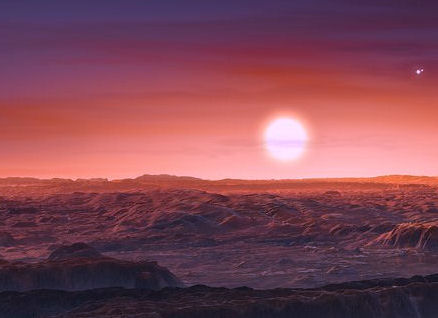
Image Credit: ESO/M. Kornmesser
The habitability or otherwise of Proxima b depends upon many factors, a lot of which are essentially still educated guesses. Red dwarfs produce powerful flares which may, over time, strip atmospheres from rocky planets in their immediate vicinity. Proxima Centauri is thought to emit flares every 20 minutes or so, most of which are relatively insignificant. But extrapolations from the data available so far about the red dwarf indicates that it is capable of dealing out about 10 flares each year powerful enough to erode the atmosphere of a nearby orbiting planet (9, 10). Which then leads to another important factor - whether Proxima b has a magnetic field capable of withstanding this kind of steady assault? This is very much an open question.
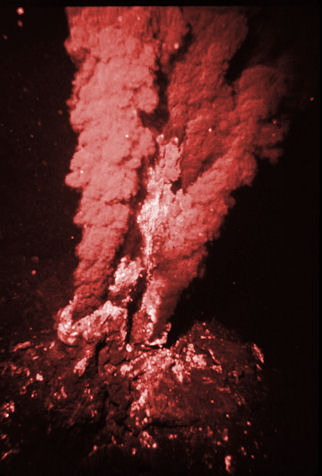
Image Credit: OAR/National Undersea Research Program (NURP); NOAA
Life might arise in an ocean which, like some of the Galilean moons of Jupiter, is encased within a protective global ice sheet. It's likely to be cold enough for a significant distribution of ice, whether the planet is tidally locked or not.
"The research (8) reveals that if the planet’s temperature were down to its sun alone, its surface would be, on average, a chilly -40C. “It seems cold, but then if you look at the same numbers for Earth you would get minus 20, minus 30C,” says [Guillem] Anglada-Escudé [from Queen Mary, University of London]. “What keeps Earth warm is basically that it has an atmosphere and an ocean,” he adds, pointing out that should the newly discovered world also boast an atmosphere, its temperature would likewise be higher." (7)
Astronomers will now be wanting to get a closer look at this new planet, particularly if it transits across the face of Proxima Centauri, thus allowing any possible atmosphere it may have to be glimpsed. That's a big ask, but not impossible with up-coming technology.
Very much ahead of the game, some theoretical work has already been carried out by Cuban astrobiologists addressing the potential for life to emerge on a planet in the Proxima Centauri system (11). Under the conditions imagined for such a world, the need for a photosynthesis process driven by infrared light seems to be an important requirement. Such a process is certainly possible, as has been discovered around hydrothermal vents at the bottom of our world's oceans (12). Ironically, the very same flares emitted by the red dwarf star that might cause long-term cause erosion to Proxima b's atmosphere could also be the life-givers of oceanic biological processes. Red dwarf flares might be problematic for atmospheres, but would surely aid oceanic photosynthesis.
Travel to Proxima b
Is it feasible to send a probe to Proxima b, once it has been established that there's a reasonable chance of life there? Many articles considering this possibility tend to extrapolate the time needed to get there from the distance involved (4.24 light years) and the speed of our current rocket or ion drive technology. Figures of 70-80,000 years get banded about based upon existing spacecraft velocities:
"If Voyager 1 was traveling in the direction of the red dwarf Proxima Centauri at a constant velocity of 60,000 km/hr, it would take 76,000 years (or over 2,500 generations) to travel that distance. But if it could attain the record-breaking speed of Helios 2‘s close approach of the Sun – a constant speed of 240,000 km/hr – it would take 19,000 years (or over 600 generations) to travel 4.243 light years. Significantly better, but still not in the ream of practicality." (13)
Although true, these times assume that a craft is initially accelerated up to then settle into a cruising speed for almost the entirety of the journey. A spacecraft exhibiting the capability to constantly accelerate during its journey quickly picks up a real head of steam, and potentially could attain velocities that are in the order of a fraction of the speed of light. That spacecraft would, however, also need to decelerate during the second half of the journey so that it doesn't rush through the target star system like an express train through a sleepy rural station. That limits a spacecraft designed using current nuclear technologies to a 1000 year flight time - still a considerable saving (13)!
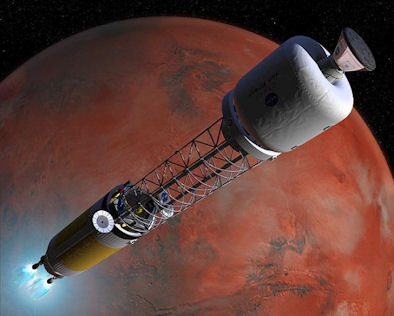
Artist's impression of a thermo-nuclear rocket decelerating towards Mars.
Image Credit: NASA
The best bet seems to be the long-awaited advent of nuclear fusion technology, which could, potentially, reduce the flight time to Proxima Centauri to between 36 and 40 years (13,14). Other possibilities have been theoretically explored, of course, but would require huge research investments, beyond even the wildest dreams of our modern scientific communities. The best bet seems to be to continue to improve our imaging technologies, and take a closer peak at this wonderfully exciting new world.
Written by Andy Lloyd, 17th-28th August 2016
References:
1) Olaf Stampf "Faraway, So Close! Earth-Like Planet Discovered Orbiting Proxima Centauri" 16 August 2016,
2) Pale Red Dot "Intensifying the Proxima Centauri Planet Hunt" 24 January 2016
3) David Dickinson "Hunting for Planets Around Proxima Centauri" 25 January 2016
4) Eric Mack "What life would be like on an Earth-like planet around Proxima Centauri" 16 August 2016
5) Andy Lloyd "Search for Alien Life" 28 January 2016
andylloyd.org/darkstarblog37.htm
6) Alan Boyle "SETI Institute launches radio search for alien life amid 20,000 red dwarf stars" 30 March 2016
7) Nicola Davis "Discovery of potentially Earth-like planet Proxima b raises hopes for life" 24 August 2016
8) Guillem Anglada-Escudé et al. "A terrestrial planet candidate in a temperate orbit around Proxima Centauri" Nature 536, 437–440, 25 August 2016
9) Jacob Aron "Proxima b’s star could be blasting away the planet’s atmosphere" 26 August 2016,
10) James R. A. Davenport et al. "MOST Observations of our Nearest Neighbor: Flares on Proxima Centauri" ApJ Letters, 24 August 2016
11) Madeleine Lopez et al. "On the habitability of exoplanets orbiting Proxima Centauri" Revista Cubana Fisica, 30: 77, 11 January 2014 with thanks to Eitan
12) Adam Hadhazy "Infrared Photosynthesis: A potential power source for alien life in Sunless Places" 6 Jun 2013
13) Matt Williams "How long would it take to Travel to the Nearest Star?" 9 August 2016
14) Kip Thorne "The Futuristic Technology That Could Enable Interstellar Travel" 14 November 2014
Going the Wrong Way Round
A new Trans-Neptunian Object has been discovered whose quirkiness is breaking into new territory. This object, currently named 'Niku' after the Chinese adjective for 'rebellious', is seriously off-piste and heading in a highly inclined, retrograde motion around the Sun (1). Does this sound familiar? The retrograde motion is something which Zecharia Sitchin claimed for the rogue planet Nibiru. Niku...Nibiru. It sounds like the team who discovered this object, based at the Harvard-Smithsonian Center for Astrophysics (2), are having a bit of fun with us. Rest assured, this is not Nibiru, or anything like it. That said, something in the past interacted with this object to fling it into its strange orbital path, and at the moment the identity of that strongly perturbing influence is a definitive 'unknown'.
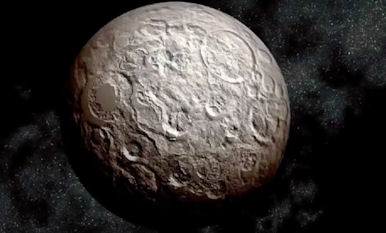
Additionally, Niku's discovery has prompted the astrophysics team to consider a new cluster of objects (high inclination TNOs and Centaurs) which appear to share the same orbital plane. This, in itself, is an unexpected and exciting development. Could the influencing factor be the mysterious Planet Nine (3)?
"...The new TNO appears to be part of another group orbiting in a highly inclined plane, so [Matthew] Holman’s team tested to see if their objects could also be attributed to the gravitational pull of Planet Nine. It turns out Niku is too close to the solar system to be within the suggested world’s sphere of influence, so there must be another explanation. The team also tried to see if an undiscovered dwarf planet, perhaps similar to Pluto, could supply an explanation, but didn’t have any luck. “We don’t know the answer,” says Holman." (1)
Dynamically, Niku is very similar to an object described in 2008, which also moves the wrong way round the solar system. This Kuiper Belt Object is known as 2008 KV
42, nicknamed Drac due to its vampire-like ability to walk on walls, also has an inclination greater than 90 degrees, which creates the retrograde motion (4). It is thought that this KBO originated from the inner Oort Cloud, some 2000-5000AU away, and is in a transitional phase prior to becoming a Halley Comet-like object.In which case, the next logical question to ask is what knocked these objects off their perch in the inner Oort Cloud, sending them into this highly inclined cluster of orbital paths in the vicinity of the Edgeworth-Kuiper Belt? Is this a hint that the orbital path of Planet Nine, itself inclined to the ecliptic by about thirty degrees (5), might extend far enough out into the outer solar system to skirt the inner edge of the Oort Cloud? If so, then this could explain this perturbing effect, but also extend the aphelion distance of Planet Nine out far further than currently thought. The implication of this, if we follow this argument to its natural conclusion, is that Planet Nine's mass would then be far greater than the ten Earth masses currently anticipated for it. Otherwise, it would be incapable, at these greater average distances, of pulling up the anomalous cluster of Sednoids (6) into the extended scattered disk beyond in the first place.
Note, also, that two of the lead authors of this new paper are astronomers from Harvard who, when scrutinising astrometry data on Pluto and other trans-Neptunian objects, have previously argued for either the existence of a second perturbing planet, or a significantly more massive Planet Nine body (7). I asked one of them, Dr Matthew Holman, whether the proposed Planet Nine body - this time with greater mass and orbital period - might have been capable of drawing down Niku from the inner Oort Cloud, to which he responded:
"I really have not figured out the explanation for the common plane, prograde and retrograde, that these objects seem to share, but it's not clear to me that if something like a Planet Nine is perturbing them that it would need to have such a large aphelion. The gravitational influence of the disk and bulge of the galaxy are strong enough [to] reduce the pericenters of inner Oort cloud objects into the region of the planets." (8)
This seems to boil down to whether objects originally located in the inner Oort Cloud require a special perturbing nudge to send them down towards the Kuiper Belt, or whether the standard forces at play in the galactic environment are sufficient to the task. In the case of Drac, Brett Gladman of the University of British Columbia, whose team discovered 2008 KV42, may seem more inclined towards a more localised nudging mechanism, as reported here:
"It seems likely that Drac was gravitationally disturbed from its home in the inner Oort Cloud by a passing star, or some other disturbance in its local space. It then fell toward the inner Solar System where it found its new home near the Kuiper Belt." (4)
Although the press release by the Canada France Ecliptic Plane Survey discusses a possible migration between the inner Oort Cloud and the Kuiper Belt, it does not specify how such a movement may have been initiated (9).
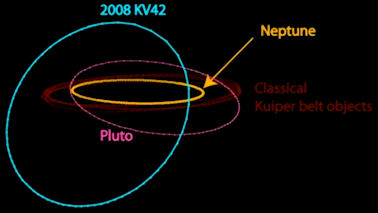
A connection between Drac and Planet Nine has also been alluded to on the Wikipedia page devoted to 2008 KV42:
"2008 KV42 may even provide evidence of Planet Nine. The Kozai effect inside the mean-motion resonances with Planet Nine may cause a periodic exchange between its inclination and its eccentricity. When the elongated perpendicular centaurs get too close to a giant planet, orbits such as that of 2008 KV42 are created." (9)
This note builds upon Mike Brown's essay about Planet Nine, where he discusses its potential connection to Drac:
"And Drac, which had been such a disappointment? Once we started looking we realized that our gravitational simulations create Drac, too. Sometimes, when the elongated perpendicular Centaurs do get too close to giant planet [sic], that planet pulls their orbit a little close, and also swings the orbit around randomly. Another Drac is born. The Planet Nine hypothesis requires the existence of objects with orbits like Drac, which otherwise had no plausible explanation." (10)
So, according to Dr Brown, Drac was originally a Centaur object located between Jupiter and Neptune, which was dragged out into its perpendicular, retrograde orbit by Planet Nine, presumably when near perihelion. Perhaps he has not yet considered that it might have pulled Drac in from the inner Oort Cloud?
Written by Andy Lloyd, 14th August 2016
References:
1) Shannon Hall "Mystery object in weird orbit beyond Neptune cannot be explained" 10 August 2016, with thanks to Mart and Lee
2) Ying-Tung Chen et al. "Discovery of A New Retrograde Trans-Neptunian Object: Hint of A Common Orbital Plane for Low Semi-Major Axis, High Inclination TNOs and Centaurs" ApJ Letters, 5 August 2016
3) "Mystery Object in Weird Orbit Beyond Neptune Cannot Be Explained"
youtube.com/watch?v=93oBy-x5gjs
4) Ian O'Neill "Kuiper Belt Object Travelling the Wrong Way in a one-way solar system" 5 September 2008
5) Konstantin Batygin & Michael Brown "Evidence for a Distant Giant Planet in the Solar System" The Astronomical Journal, 151:2, 20 January 2016,
6) Chad Trujillo & Scott Sheppard "A Sedna-like body with a perihelion of 80 astronomical units" Nature, 507, 471-474, 27 March 2014
7) Matthew Holman and Matthew Payne "Observational Constraints on Planet Nine: Astrometry of Pluto and Other Trans-Neptunian Objects" The Astronomical Journal 152(4), 30 Mar 2016
8) Correspondence from Matthew Holman, 18 August 2016
9) CFEPS Press Release "Discovery of the Retrograde Trans-Neptunian Object 2008 KV42" relating to: B. Gladman et al, The Astrophysical Journal 697(2):L91 16th July 2008
10) Mike Brown "Why I believe in Planet Nine" 12 February 2016
Not Enough Dusty Disks
As more rocky exoplanets are discovered orbiting neighbouring stars, questions are now being raised amongst academics about whether there are sufficient numbers of warm protoplanetary disks observed around young stars to statistically account for them all.
"The high occurrence rate inferred for Earth-mass planets around mature solar-type stars based on exoplanet surveys (roughly 20%) stands in stark contrast to the low incidence rate (less than 2-3%) of warm dusty debris around solar-type stars during the expected epoch of terrestrial planet assembly (roughly 10 Myr). If Earth-mass planets at AU distances are a common outcome of the planet formation process, this discrepancy suggests that rocky planet formation occurs more quickly and/or is much neater than traditionally believed, leaving behind little in the way of a dust signature. Alternatively, the incidence rate of terrestrial planets has been overestimated or some previously unrecognized physical mechanism removes warm dust efficiently from the terrestrial planet region." (1)
The solution to this glaring dilemma advocated by Scott Kenyon, of the Harvard-Smithsonian Center for Astrophysics, and his colleagues, is that the speed with which planets form from the dusty disks surrounding very young stars is much quicker than thought - allowing more planets to form in the potentially shortened time these disks are in place. Either the low incidence of warm dust disks needs to be explained, or the large quantity of rocky planets must be accounted for in other ways. Bear in mind that the number of rocky planets being discovered is likely to be the tip of the proverbial iceberg, as the technology to detect small planets continues to improve year on year.
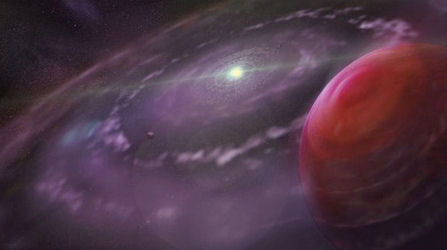
They also consider whether there are other ways for dust to be removed from planetary environments around new stars, perhaps by 'gas drag'. As an online commentator noted:
"Gas drag will definitely moderate the movements of dust particles so instead of colliding and scattering and/or shattering, they flow together. This enables gravity wells to very quickly clean up the dust and other debris within a solar system type nebula." (2)
I'm quite convinced that the planet-forming process is not limited to accretion within swirling dust disks around young stars, but that it is an ongoing process within a variety of environments. As planetary scientists think hard about the anomalies being thrown up by exoplanet observations, I hope that progress will be made towards a new model of planet formation: One that may lead to the formation of planets beyond the traditional planetary zones of stars.
Written by Andy Lloyd,
28th August 2016
References:
1) Scott J. Kenyon et al. "Rocky Planet Formation: Quick and Neat" The Astrophysical Journal, 831:1, 18 August 2016,
2) 'Java55' 23rd August 2016
Complex Brown Dwarf Systems 'Baffle' Astronomers
A couple of brown dwarfs have been discovered in a close binary system some 240 light years away, whose two stars circle each other at a distance of about 19AU, similar to that of Uranus around the Sun. The two new exoplanets orbit close to the primary Sun-like star HD 87646 (1). These two sub-stellar companions are HD 87646b, which is a minimum 12MJupiter sub-brown dwarf (a 'hot Jupiter'-type exoplanet) orbiting every 13 days just 0.117AU from the star (2); and HD 87646c, which is a 57MJupiter brown dwarf circling the star every 673 days (1). The orbital eccentricity of the brown dwarf is greater than that of the inner sub-brown dwarf, which is in keeping with other observations of brown dwarfs orbiting stars.
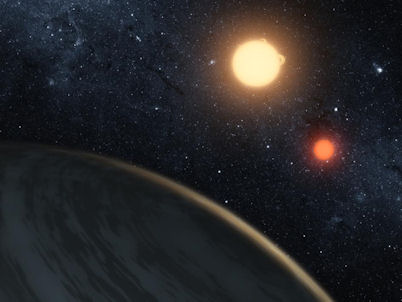
Image credit: NASA
The international team that discovered
this remarkable system is perplexed as to how it might have come about:
"Given the fact that HD 87646 is the first
known system to have two massive substellar objects orbiting a star in a
close binary and the masses of the two objects are close to the minimum
masses for burning deuterium and hydrogen, these peculiarities raise
questions about the system's formation and evolution.
""The large masses of these two substellar objects
suggest that they could be formed as stars with their binary hosts: a
large molecular cloud collapsed and fragmented into four pieces; the
larger two successfully became stars and formed the HD 87646 binary, and
the other smaller ones failed to form stars and became the substellar
objects in this system. This scenario might be relevant for the binary
stars but seems problematic for the two substellar objects on orbits
within one AU because it is unclear whether fragmentation on such a
small scale can occur," the paper reads (1)
"Other hypothesis offered by the scientists is
that the two newly discovered giant objects were formed like giant
planet in a protoplanetary disk around HD 87646A. However, they added
that such massive disks are rare in close binaries, and further
investigation is needed to confirm this explanation." (3) Given the large number of substantial exoplanets and
brown dwarfs discovered over the last couple of decades, finding a
couple more in a close binary system may not seem so surprising.
We've got used to the fact that the classical planet-forming model,
which described how the solar system came about so well, simply does not
apply to the diversity of planetary systems emerging from the ballooning
exoplanet data (now >500). According to the core accretion model, the nature of
the close binary system should create problems for giant planet
formation, because gravitational perturbations inhibit the growth of
planetessimals in the protoplanetary disk, meaning that the formation of
a planetary core is slowed down. The dust disk will essentially
dissipate before the planetary core can amass gaseous material around it
to form a gas giant of brown dwarf. Furthermore, given the sheer
size of these brown dwarf companions, the initial disk would have to be
massive to have formed them. This isn't generally seen in young
close binary systems, meaning that the disk should have dissipated way
faster than the time required for giant planet formation (1). This
is a similar issue to that recently raised for rocky planet formation
(4).
Image Credit: Janella Williams, Penn State University Another theory of planet formation relies on disk
instability, which doesn't suffer the same problems in this case as the
core accretion model. The authors are, however, cautious of
advocating this mechanism for the complex
HD 87646 case as it's not clear whether disk instability can be
triggered in the presence of a close stellar companion (1). The
planet-forming mechanism in this case remains a mystery, although the
authors do offer ideas about the migration and scattering of these
companion objects post-formation. An alternative which would not have been considered
by mainstream astrophysicists is the radical model of planet formation
proposed by the French engineer François Berguerand, whom advocates the
action of a passing star to draw out a spindle of stellar matter from a
young star. This spindle of dense matter then separates out into
gaseous planets (5). This close binary system would seem to
provide the perfect opportunity for the drawing out of such matter to
create the substantial brown dwarf companions for the primary star.
I've written to François for comment.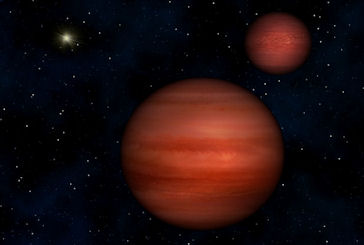
Brown Dwarf Discovered Orbiting Star HR 2562
Perhaps also of some relevance to the case of HD 87646 is the recent announcement of a 30M
Jupiter brown dwarf discovered lurking within the inner hole of a dust disk encircling the star HR 2562 (6). At 1.3 MSun, the masses of these primary stars are essentially the same. Although the presence of the circumstellar disk would seem to imply a youthful star, the age of HR 2562 remains a subject of some debate. It's thought to be about 600 million years old, based upon evolutionary models.The disk spans from 38 to 75 AU away from the host star, with the brown dwarf, designated HR 2562B, located some 20AU from the star (7). This is a similar distance as the secondary star in the HD 87646 binary.
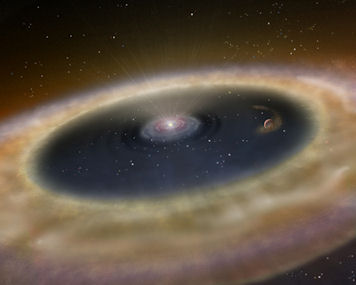
Image Credit: Karen L. Teramura, UH IfA
Most star systems have lost their dust disks by 300-400 million years (8). Rare circumstellar dust disks around older stars are then thought to arise as a result of collisional cascades between rocky objects, like asteroids and comets, in planetary systems (9) in what are otherwise dynamically calm environments. As a result of this hypothesis, older star systems which exhibit dust disks are considered good candidates for the presence of terrestrial planets (10). The solar system should perhaps also exhibit this kind of dust disk, given its perceived general stability. the fact that it doesn't is thought to be due to the decimation of the Kuiper Belt which took place around 3.9 billion years ago:
"Intriguingly, our solar system looks unusual... because it has rocky planets as well giant planets that are relatively calm in terms of their orbital dynamics, but no debris disk.
"“So, why don’t we have this dust?” [Sean] Raymond [of the Observatory of Bordeaux, France] said. “Well, it turns out that for more than half a billion years after its formation, the solar system did have a bright debris disk! As is the case for other stars, the dust was produced by icy planetesimals occasionally colliding and grinding themselves away. This population of planetesimals was the primordial Kuiper belt, and we think it contained about 50 Earth masses of material, at least 100 times more mass than it does today.”
"However, the Kuiper belt was almost completely cleared out during a period instability about 3.8 billion years ago that is linked with the “Late Heavy Bombardment,” when asteroids were slung around the solar system, leaving planets with scars often still visible today." (11)
I consider this event to be the result of the infiltration into the planetary zone of a rogue sub-brown dwarf object which, I believe, still remains undiscovered in the outer reaches of the solar system. Its presence has indeed eliminated much of the Kuiper Belt, and created the 'Kuiper Cliff' at about 50AU.
By contrast, what we have in the case of HR 2562 is an inner brown dwarf, surrounded by an outer circumstellar disk. This would then imply that the bulk of the system's rocky material - asteroids, terrestrial planets, planetessimals - lies beyond the the reach of a substantial inner sub-stellar companion.
Or is it actually an example of the way a sub-stellar companion can 'sweep out' a region of space? In the case of our solar system, this is what I believe has occurred between the Kuiper Belt and the inner Oort Cloud (i.e. between 50 and 2000AU).
Written by Andy Lloyd,
29th August 2016
References:
1) Bo Ma et al. "Very Low-Mass Stellar and Substellar Companions to Solar-like Stars From MARVELS VI: A Giant Planet and a Brown Dwarf Candidate in a Close Binary System HD 87646" The Astronomical Journal, 152: 112, 11 Aug 2016,
2) New World Atlas "HD 87646 b" (Resource no longer available)
3) Tomasz Nowakowski "Giant planet and brown dwarf discovered in a close binary system HD 87646" 16 August 2016, with thanks to Lee
4) Scott J. Kenyon et al. "Rocky Planet Formation: Quick and Neat" The Astrophysical Journal, 831:1, 18 August 2016,
5) Andy Lloyd "Our Solar System: An Alternative Birth" 25 September 2015
andylloyd.org/darkstarblog30.htm
6) Tomasz Nowakowski "Astronomers find a brown dwarf companion to a nearby debris disk host star" 26 August 2016, with thanks to Mark
7) Quinn M. Konopacky et al. "Discovery of a Substellar Companion to the Nearby Debris Disk Host HR 2562" The Astrophysical Journal Letters, 829:1, 23 August 2016,
8) H. J. Habing et al. "Disappearance of stellar debris disks around main-sequence stars after 400 million years" Nature, 401, 456-458, 30 September 1999
9) Rahul Patel “Debris Disks: Searching for Dust to Find Planets” 4 March 2015
sciencesprings.wordpress.com article
10) S. N. Raymond et al. "Debris disks as signposts of terrestrial planet formation" June 2011, Astronomy & Astrophysics, 530: id.A62
11) Charles Q. Choi "Stars with Dusty Disks Should Harbor Earth-like Worlds" 9 March 2012
The Antidote to Dark Matter?
My friend and fellow researcher Lee Covino sent me an article recently which, on the face of it, appeared to have little to do with my Dark Star stuff. It was about Ultra-Diffuse Galaxies (UDGs), particularly a mass of these objects in the Coma cluster (1). The evident lack of stellar mass in these galaxies, compared with their implied total mass, shows that these galaxies have a much lower quantity of normal 'baryonic' matter than the universe average (2), which implies, say cosmologists, the dominant prevalence of Dark Matter.
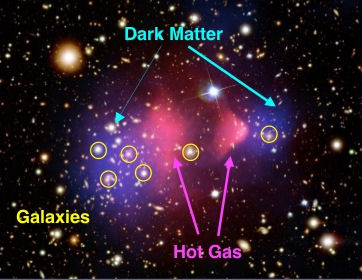
Image Credit: M. Markevitch & D. Clowe
Perhaps the normal mechanism whereby stars form en masse within a central galactic core was somehow interrupted, some wonder:
"We suggest that UDGs like DF17 may be "pure stellar halos", i.e., galaxies that formed their stellar halo components, but then suffered an early cessation in star formation that prevented the formation of any substantial central disk or bulge." (3)
In which case, one might ask, what happened to all that material which did not end up firing up stars, like in 'normal' galaxies?
There's a ton of missing mass in the universe, and it's a big puzzle:"As radio and optical observations have extended the velocity measurements for the stars and gas to the outer regions of spiral galaxies, they have found that the stars and gas clouds are moving at the same speed as the ones closer in! A substantial part of the mass of the galaxy is not concentrated toward the center of the galaxy but must be distributed in some dark, unseen halo surrounding the visible galaxy. The outer regions of galaxies, faint and inconspicuous on a photograph, may actually contain most of the matter." (4)
The gravity effects created by this missing dark mass can be seen through gravitational lensing effects, X-ray emissions from hot gas within galactic clusters (as well as an unexpected scattering of their radial velocities). To explain it, cosmologists have come up with a theoretical form of matter which does not interact with the electromagnetic spectrum at all.
The best direct evidence for this so-called 'Dark Matter' is thought to derive from two colliding clusters of galaxies known as the Bullet Cluster (5).
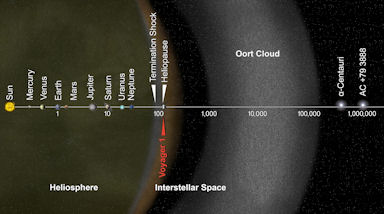
The Solar System on a logarithmic scale of Astronomical Units.
Image credit: NASA / JPL-Caltech
By definition, dark matter is unobservable directly, and thus ultimately unprovable - until the day particle physics pops it out of a hat (or suitably massive particle accelerator). This all sounds a bit like pseudo-science, doesn't it? Dark Matter conveniently plugs a huge hole in cosmology.
Free-floating Planets and Brown Dwarfs
So, an alternative possibility is that a huge quantity of unaccounted 'normal' baryonic matter is out there, but not to be found in visible stars, nor in enormous gas /dust clouds. This missing matter (which is 'dark', but not actually exotic) would therefore be diffuse, and broken into bite-sized cosmic chunks which slip under the observable radar. Like cool, free-floating gas giant planets moving through the vast gaps between stars, for instance. These might be as large as failed stars - ultra-cool brown dwarfs, up to old red dwarfs. Could this help solve the mystery of the missing 90% of the mass of the universe?
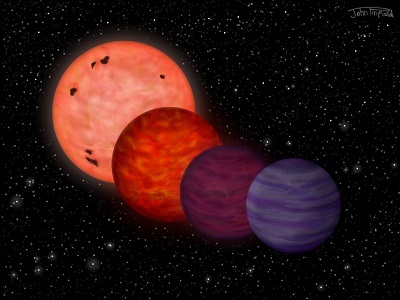
The problem then is that the sheer number of these would have to be truly enormous to account for the missing mass of galaxies. Perhaps 1000s of these free-floating planetary objects for every visible star; with a distribution which tends to place these dark, lower mass objects into the outer peripheries of the galactic environment. Such a suggestion has been considered historically as an alternative explanation to Dark Matter:
"Another durable suggestion has been that a major part of the missing mass in galaxies and clusters of galaxies is made up of very low mass stars. These stars, which would have masses of only a few percent that of the Sun, are red, brown, and black dwarf stars. These stars are very dim because of their small size and low surface temperature. The red dwarfs, which have a mass of 10 to 50 percent that of the Sun, are known to be very common in the solar neighborhood. Of the 90 nearest stars to the Sun that have been classified, 62 of them are red dwarfs. Red dwarf stars produce intense radio, optical, and X-ray flares. This property should make it possible for advanced X-ray telescopes, working in concert with the Space Telescope, to attack the question as to whether 90 percent of the matter on the edges of galaxies is in the form of red dwarf stars.
"Brown and black dwarfs are a much more difficult proposition. These objects, which are essentially freely wandering Jupiter-like objects, are so dim that it may be impossible to ever detect them. Although there are no sound theoretical reasons for believing that they exist in the required numbers, it is possible that such objects were produced in large numbers by the star formation process in globular clusters long ago, when galaxies were just beginning to form. The black and brown dwarfs may then have diffused out of their star clusters and formed very large halos around galaxies. Because of their low luminosities, they would be extremely difficult to detect, even if there were quadrillions of them around every galaxy."
(4)J
ust because these objects might not be immediately obvious in our stellar neighbourhood, does not mean that they are not abundant elsewhere, of course. But, how could so many of these objects have formed? I would argue that such a radical model implies a completely different model of planetary formation in interstellar environments, as well as a mechanism whereby these interstellar planets tend to migrate out to the edges of the galaxy over time.Right now, such ideas seem out of favour in the astrophysics community, despite a far more concrete understanding of the nature and prevalence of ultra cool brown dwarfs, free-floating planets, and so on. This is likely because a good understanding of how many such objects form in the first place remains elusive - beyond the undoubted potential for some giant planets to be ejected from their parent systems early in the standard planet-forming process. But this seems insufficient to account for the need for thousands of such objects for each star, unless they could actually be forming independently in interstellar space. I'm personally quite intrigued by such an idea, and would like to further this concept into a more credible mechanism in the future. We'll see.
But this is not the only possibility on the table. More recent work on the role played by normal baryonic matter in the voids between galaxies has described webs of immense filament structures between galactic clusters:
"Observations of the afterglow of the Big Bang known as the cosmic microwave background (CMB) suggest that protons, neutrons and other (three-quark) baryon particles only account for about 5% of the universe's energy density – the rest is believed to consist of enigmatic dark matter and dark energy. However, the combined mass of all of the stars within a radius of about a billion light-years from Earth only amounts to about 2.5% of the energy density within that region. Computer simulations predict that the missing baryons instead exist within low-density plasma filaments millions of light-years long." (6)
So, according to this theory, much of the missing baryonic mass does indeed seem to be extra-galactic, and strung out into hot, plasma filaments of unbelievable proportions (7). Is this more credible than a dark halo of 'lost' failed stars and ejected planets? Or could there be a connection between the two, where these hot plasma filaments are a source of non-stellar planetary formation?
If we return to the interstellar planet idea, then would the interstellar space between stars not also contain a far greater number of these kinds of objects than previously thought? Results from infra-red sky surveys like WISE would tend to cast doubt on such a possibility - at least for the hotter end of the failed star spectrum, anyhow. In which case, the distribution of this dark interstellar planetary mass would need to be predominantly Jovian and lower.
An additional repercussion here would be a far greater rate of influx of such objects through the solar system during its lifetime. After all, if interstellar space contains a great number of independent planetary bodies, then it stands to reason that the chance of one grazing the solar system over time increases accordingly. This would help to explain the origin of the fabled planet Nibiru, one might argue.
Comets
An allied concept is that the comets conventionally thought to arrive from the Sun's distant Oort Cloud are instead interstellar interlopers. In other words, one might argue that comets are, essentially, travellers between the stars which occasionally trespass into stellar environments. Astronomers can determine from the trajectory of long-period comets whether they originated within the solar system, or entered the solar system from the interstellar space between the stars. Interstellar comets should have hyperbolic trajectories, which would allow them to pass cleanly through the solar system.
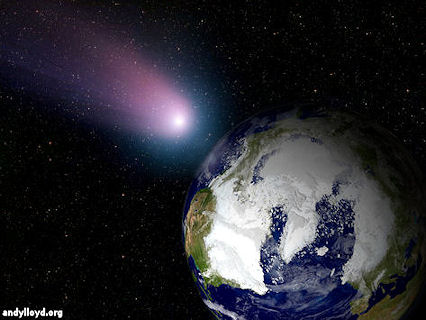
It turns out that the appearance of interstellar comets is a rare phenomenon (none actually observed in the last 150 years), a finding which is in keeping with their low theoretical population in the local galactic vicinity (8). That does not stop some astronomers of my acquaintance from questioning the very existence of the Oort Cloud. Indeed, the LINEAR
(Lincoln Near-Earth Asteroid Research) survey showed many fewer comets than previously assumed, lowering estimates for the population of the Oort Cloud generally (9). There were more surprises:"The results [from LINEAR] are surprising in three ways. Firstly, the flux of comets through the inner solar system is much lower than some previous estimates. Secondly, the expected rise in comet numbers to larger perihelia is not seen. Thirdly, the number of comets per unit absolute magnitude does not significantly rise to fainter magnitudes. These results imply that the Oort cloud contains many fewer comets than some previous estimates, that small long-period comets collide with the Earth too infrequently to be a plausible source of Tunguska-style impacts, and that some physical process must have prevented small icy planetessimals from reaching the Oort cloud, or have rendered them unobservable." (9)
There seems to be a real problem with the population of small comets, particularly those less than 100m diameter. Small comets of about 10m diameter were thought to be entering the Earth's atmosphere routinely, but radar surveys completely failed to detect them (10). These kinds of icy objects had been thought to have supplied the Earth with its oceanic waters over time, but this 'late veneer theory' has become increasingly troubled as scientific knowledge about comets, and their prevalence (or lack thereof), has advanced.
So, comets seem to be of declining importance in terms of population in the solar system, and beyond. Perhaps a much greater population of dark planet-sized objects out in interstellar space is having an effect upon these populations - shepherding them, and regulating their surprisingly low numbers. I wonder whether they're wrapped up into the process of continuing accretion, which I've been proposing lately (11), as the building blocks that these scattered planetessimals are considered to have once been.
Written by Andy Lloyd,
16th August 2016
References:
1) "Astronomers Discover 854 Ultra-Diffuse Galaxies in Coma Cluster" 23 June 2015, with thanks to Lee
2) Jin Koda et al. "Approximately A Thousand Ultra Diffuse Galaxies in the Coma cluster" The Astrophysical Journal Letters, 807:1 4 June 2015,
3) Eric Peng et al. "A Rich Globular Cluster System in Dragonfly 17: Are Ultra-Diffuse Galaxies Pure Stellar Halos?" The Astrophysical Journal Letters, 822(L31):6, 26 April 2016
4) "The Mystery of the Missing Mass"
5) Douglas Clowe et al. "Weak lensing mass reconstruction of the interacting cluster 1E0657-558: Direct evidence for the existence of dark matter" The Astrophysical Journal, 10 December 2003
6) Edwin Cartlidge "Universe's missing mass found in the cosmic web" 2 December 2015,
7) Dominique Eckert et al. "Warm-hot baryons comprise 5-10 per cent of filaments in the cosmic web" Nature, 528, 105–107, 3 December 2015,
8) A. K. Sen & N. C. Rama "On the missing interstellar comets" Astronomy and Astrophysics, 275: p. 298 (1993),
9) Paul Francis (2005-12-20). "The Demographics of Long-Period Comets" 20 December 2005, The Astrophysical Journal, 635 (2): 1348–1361,
10) S. Knowles "A search for small comets with the Naval Space Command radar" Journal of Geophysical Research, 104: A6, 12637–12643,
1 June 1999
onlinelibrary.wiley.com article
11) Andy Lloyd "Interstellar Planet Formation" 17 July 2016,
andylloyd.org/darkstarblog40.htm

You can keep informed of updates by following me on Twitter:
![]()
Or like my Facebook Page: https://www.facebook.com/darkstarandylloyd